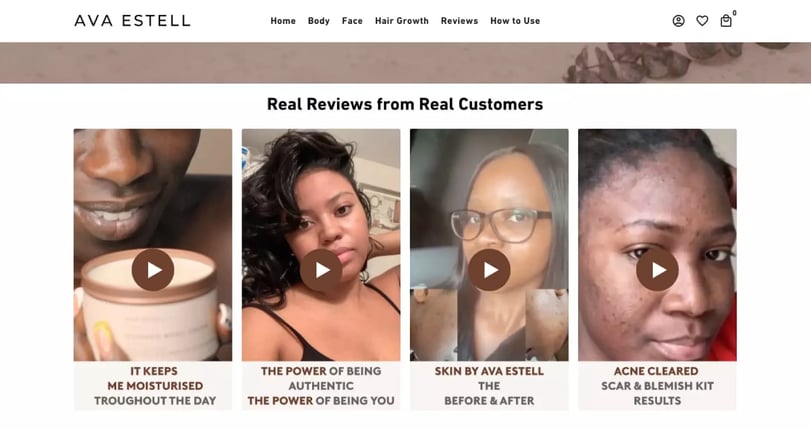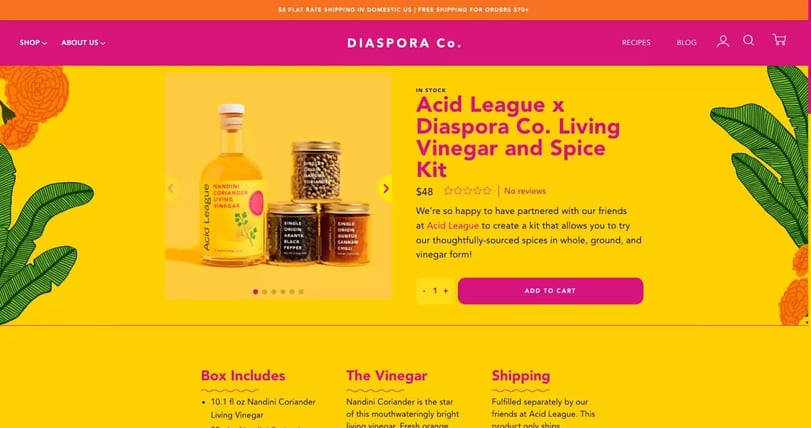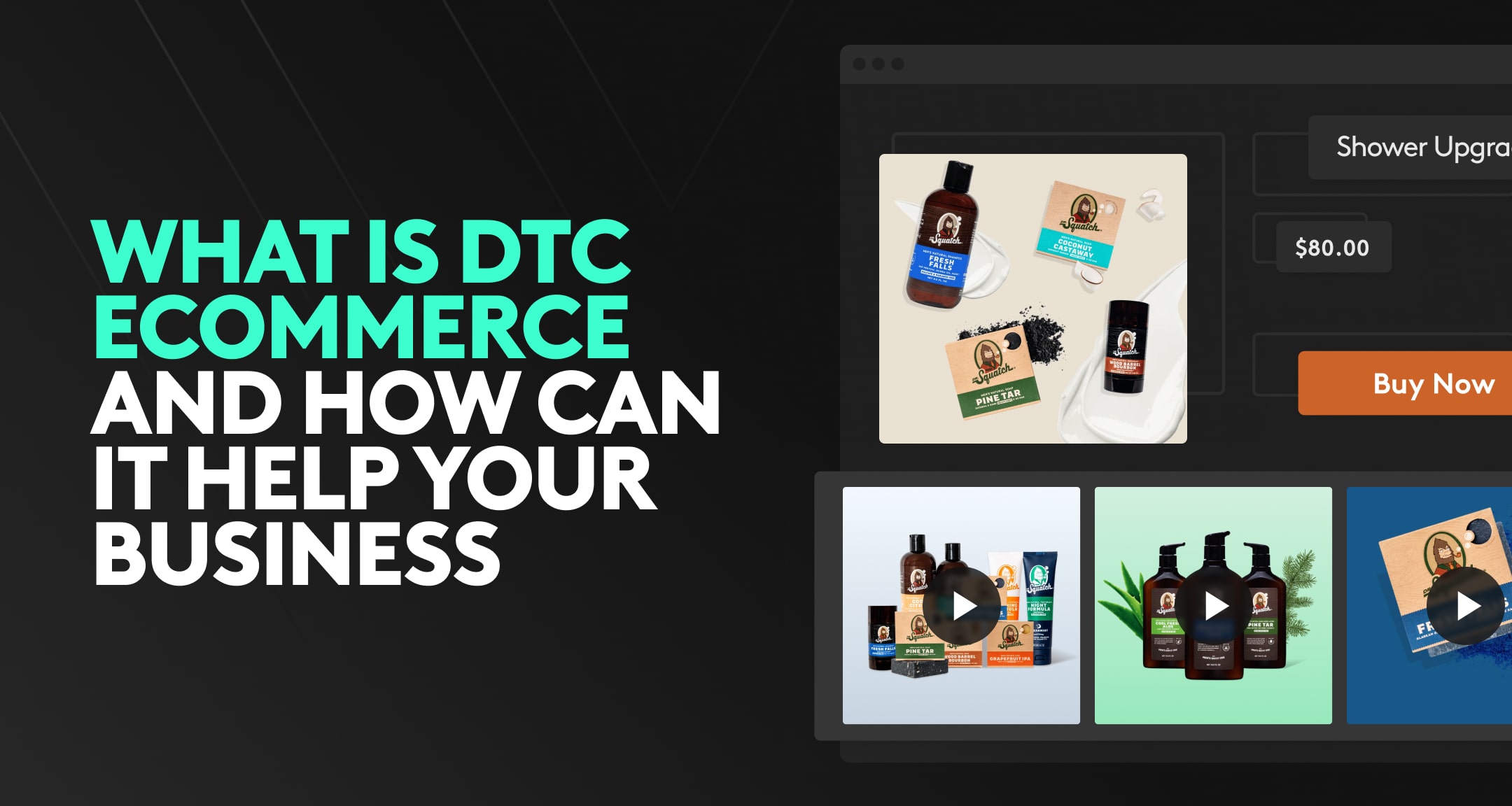Share
In the US alone, 13% of eCommerce businesses are DTC, with sales predicted to be worth $161.22 billion by 2024. More and more manufacturers are adopting this model due to the increasing number of individuals who shop online, post-pandemic, despite the IRL shopping recovery.
Wondering what exactly DTC eCommerce is and why it is essential? Keep reading as we're about to cover all about DTC in this blog post.
What is DTC eCommerce?
Direct-to-consumer (DTC) eCommerce refers to an online retail business model in which a company sells its products directly to consumers through its website or online platforms rather than using intermediaries such as physical stores or online marketplaces.
DTC eCommerce helps manufacturers have a direct relationship with their customers and to control the customer experience from start to finish through product development, marketing, sales, and customer service.
Brands like Nike have incorporated the DTC model due to its personalization abilities and flexibility to serve customers effectively. Literally, any business can now succeed online with this model due to the minimal entry requirements and resources available.
It has become increasingly popular in recent years as more consumers shop online and companies seek to differentiate themselves in a crowded marketplace.
What Are The Advantages of Direct-To-Consumer eCommerce?
-
Increases Customer Loyalty
-
Helps Deliver Personalized Shopping Experiences
-
Distinguishes Your Brand From The Competition
-
Gives You Control Over Distribution Channels
-
Increases Revenue
-
Better Brand Relationships
Increases Customer Loyalty
Loyalty is easily achieved when brands can personalize the shopper’s journey, as 55% of online customers prefer shopping for DTC because they get personalized experiences, while the other 40% plan to purchase from a DTC brand soon.
Adopting this model allows you to treat your customers well and to get in their good books so they stick to buying from your brand.
A few methods you can use to increase your customers’ loyalty include:
-
Offering discounts and free shipping on some products.
-
Giving gifts to loyal customers (like Gift cards, free samples, company swag or even high-end promotional products).
-
Adopting VIP memberships.
So instead of heading to retail stores to purchase your products, they’d buy directly from you online.
Helps Deliver Personalized Shopping Experiences
Besides loyalty, running a DTC business gives you detailed information about who your customers are, their preferences, likes, and dislikes. You’ll also have a basic knowledge of their demographics and purchase history.
With such valuable data, you can build personalized campaigns, optimize your marketing goals to increase customer retention, and still provide shoppers with the right products.
Distinguishes Your Brand From The Competition
To be different, your brand needs to create a solid and clear message across all marketing channels. DTC eCommerce helps you emphasize your products’ unique selling points, features, and benefits in your brand message to set you apart from competitors.
Your logos and packaging will also help customers associate your brand with unique qualities. Use exciting colors and designs to differentiate your products and attract the attention of prospects.
In essence, DTC allows your brand to stand out in a good way.
Gives You Control Over Distribution Channels
Working with numerous distribution channels sets your business up for potential issues, as disagreements and legal disputes can arise due to the complexity of supply routes. Customers may also get inconsistent messages about your products and company.
In the traditional sense, the manufacturer ships your product to a wholesaler, who sends it to a distributor, who then ships it again to several retailers before it finally reaches your customer.
But a direct-to-consumer model shortens the chain of supply. The product goes from the manufacturer directly to the consumer who ordered it online.
Besides you being in control of supply routes;
-
Customer relationships are maintained
-
Potential legal issues are avoided
-
The right messages are passed on to customers.
Increases Revenue
Going DTC is excellent for an eCommerce business’ revenue because it allows you to influence the customer journey with factors like:
-
Your brand message
-
Loyalty
-
Brand personalization, etc.
It allows you to build powerful relationships by delivering the right customer experience, increasing shoppers’ loyalty and willingness to spend more.
Better Brand Relationships
Offering a personalized customer experience in your DTC sales increases customer satisfaction. It also personalizes the customer experience beyond the initial purchase so brands can directly communicate with buyers after shopping.
In summary, selling DTC offers you the ability to build valued relationships.
What are the Disadvantages of Running a DTC Business?
Some likely disadvantages you might need to factor in when running a DTC model for your brand are:
-
Additional Costs
-
More Competition
-
Slow Deliveries
-
Strained Relationships with Retailers
Additional Costs
You might have an increased marketing budget as a DTC, but that doesn't mean you won't spend more. You’ll need to connect with shoppers deeper using storytelling, targeted advertising, and video marketing.
Your brand will also need a social presence to utilize conversions as more buying decisions are influenced by it due to customers now trusting more brands with social influence over others.
Advertisements and social media management are big-budget, so you must consider how much and what you’ll spend.
More Competition
As with everything that becomes popular, more businesses join the DTC trend, and ‘more’ means more competition for your brand.
Expect to tweak your strategies and tactics over time to effectively satisfy your target/end customers, increase conversions and maintain the sales process regularly. Doing such will keep you ahead of the competition.
Slow Deliveries
According to Diffusion, 40% percent of customers will choose a traditional retailer over a DTC brand because of faster deliveries. This is true in most cases, as buying from local stores is much quicker than receiving products ordered online.
Also, if you compare DTC businesses with giant retailers like Amazon, the latter usually offers faster deliveries, lower shipping costs, and lower product prices.
Invest more in logistics by expanding your team or hiring a logistics company to help you deliver orders faster.
Strained Relationships With Retailers
Choosing a direct-to-consumer business model may also affect your relationship with retailers as they’ll feel you may stop the partnership at any time, negatively affecting their sales and profits.
As a preventive, your products will be removed from their stores, or they may begin to make additional demands. A great way to work around this problem would be not switching to DTC entirely but still partnering with them.
5 DTC Brand Examples to Inspire Your Journey!
Here are great examples of DTC eCommerce brands:
-
Artsabers
-
Ava Estell
-
Dr. Squatch
-
Biossance
-
Diaspora
Artsabers
.jpg?width=811&height=429&name=Artsabers%20is%20a%20DTC%20brand%20(1).jpg)
Artsabers was created by a fan who wanted to live the star wars fantasy, contributing to the fandom through collaboration with high-quality manufacturers to create affordable custom t-shirts and the iconic Lightsabers.
The game changer for Artsabers was a video shopping experience - where fans can view the best of fictional and real worlds, learn about their favorite sci-fi weapons and select and make purchases directly from within the eCommerce video player.
Using this Videowise solution, Artsabers created the best on-site shoppable video experience for fans, increased conversions by 25%, and recorded €1.1Million in sales.
Read the Artsabers case study.
Ava Estell

Ava Estell is a skincare brand started by Yaw Okyere to bridge the gap between safe skincare products for people with darker skin tones. The brand has helped numerous people worldwide feel more confident in their skin by enhancing their complexion and appearance.
Ava Estell increased conversion rates by 21% and generated up to £743k in added revenue by using Videowise to embed informative videos on their Shopify store with zero impact on page speed. The videos link directly to the product pages, which helps to increase retention and engagement.
Here’s what the Founder, Yaw Okyere had to say about Videowise.
Read the Ava Estell case study.
Dr. Squatch

Dr. Squatch is a personal care brand that creates soap and deodorants for men with natural ingredients that are carefully selected to avoid skin irritation and dryness. Soaps are made using a traditional cold process where natural elements like sodium hydroxide lye and other essential oils are mixed and left to sit without external heat.
Shoppers can find detailed product descriptions with user-generated video reviews on the website. Their products are great for men with sensitive skin and are a much healthier alternative to commercial ones.
Biossance
.jpg?width=811&height=429&name=Biossance%20is%20a%20DTC%20vegan%20skincare%20brand%20(1).jpg)
Biossance is a vegan brand that sells safe and healthy skincare products. Besides selling products, it helps buyers understand how to use them, their impacts, and, most importantly, how the ingredients are sourced.
The website hosts resources on essential topics like exfoliation, vitamins, and how to manage your skin across different seasons. The brand’s unique advantage over competitors is its focus on educating customers about skincare.
Diaspora

A spice brand with a big focus on the history of spices and how they are sourced and grown. Diaspora’s products are sold out once the growing season is over, which means customers have to wait for the next season to make a purchase.
Diaspora also pays farmers an average of 4x the commodity price - a not-so-common trend. Transparency is also a top priority for this DTC brand, as everything from how ingredients are sourced to harvest years and processing methods are known to the public.
How To Get Started With Direct-To-Customer eCommerce?
Follow these steps to start a direct-to-consumer business and increase sales of your products:
-
Build a Valuable Product
-
Create An Attractive Website
-
Provide A Seamless Online Shopping Experience
-
Create A Stellar Marketing Strategy
Build A Valuable Product
This step also applies to established businesses - create products that customers will adore and buy. Your goal should be to make shoppers return for more; I’d buy something repeatedly if I enjoyed using it the first time.
A few important questions you should ask yourself at this stage include;
-
Will I handle manufacturing and packaging, or will I outsource?
-
How much would it cost me (estimated)?
Once you’ve got answers, run a test with a few samples to get the hang of things.
The next step - create an attractive website.
Create An Attractive Website
Most successful DTC eCommerce brands have an online presence, an essential channel for connecting with target customers and building credibility. You can use a website to communicate important information to shoppers, increase engagement on your website through video UGC and attract quality product leads upon proper search optimization.
Also, shoppers will browse it for inquiries or additional information instead of calling you to ask. This leaves enough time for your team to handle other essential tasks like maintaining customer relationships and goal setting.
If your DTC brand has a website already, make sure it’s attractive and optimized, and you’re good to go.
Provide A Seamless Online Shopping Experience
Customers are willing to pay more for a seamless shopping experience, and some potential strategies you could use to make the purchase process easier include:
-
Adopting Convenient Payment Methods
-
Add Shoppable Videos to Your Website
Adopt Convenient Payment Methods
Customers who buy online want to pay for products conveniently, with 33% of them in a recent survey wishing to do so with their mobile phones at all times. Ensuring that your payment channels/methods are convenient should be a top priority, as most shoppers online aren’t patient. Once the checkout process proves difficult, they’ll look for an alternative brand to purchase from.
Ensure you aren’t losing customers by optimizing payment methods to enhance DTC sales online.
Add Shoppable Videos to Your Website
Using videos to tell your brand story, how your product works and the results produced is a valuable marketing strategy, as 82% of all web traffic comes from videos. Artsabers and Ava Estell, for instance, increased conversions by 25% and 21%, respectively, using user-generated video content.
Sharing details about your brand to customers using on-site shoppable videos effectively drives conversions and sales for your products. It also helps you to educate ideal prospects about your brand.
Book a live demo to learn more about Videowise.
Create A Stellar Marketing Strategy
DTC companies need marketing strategies to reach new customers and maintain existing ones. However, creating them requires high creativity and knowledge of customer expectations and preferences. You’ll need to consider using digital channels like social media and emails for communication and information sharing.
Also, document your strategies, which will help you stay on track to measure your results.
5 DTC eCommerce Marketing Tips to Grow Your DTC Business
Here are some marketing strategies you can use to grow your direct-to-consumer brand:
-
Use Social Media To Drive DTC Sales
-
Grow Your Brand Identity
-
Monitor & Use Marketing Data
-
Try Offline Marketing
-
Tap Into Email Marketing
Use Social Media to Drive DTC Sales
Since shoppers have an ultimate say in which social platform they use, you’ll need to study their choices to reach them. For example, 83% of customers use Instagram to discover new products and services online; therefore, you must be found where your target customers are.
If your business is established, optimize your social strategy by selling solutions and publishing content that adds value to your target customers, like video user-generated content.
Learn How To Add Social Media Videos To Your Shopify Store.
Partner with Social media Influencers
Direct-to-consumer (DTC) brands can communicate with online shoppers through influencer marketing. It is another popular strategy on the increase, as 93% of marketers have used it in their overall marketing strategy.
Some popular brands have used micro and nano influencers because they are cheaper, more relatable, and have higher engagements with their communities than prominent ones. If you can afford to hire an influencer, give it a try and measure your KPIs.
Learn The Top 3 Ways To Make Influencer-Produced Content Last Longer.
Grow Your Brand Identity
.jpg?width=811&height=722&name=A%20brand%20identity%20is%20important%20for%20your%20direct-to-consumer%20brand%20(1).jpg)
Besides social media posts, what do customers think of when they see your advertisement or product? Do they think, “This business looks trustworthy,” or the opposite? Customers will feel comfortable purchasing your products/services when they trust and feel positive about your brand. This means they’ll want to buy from a business with a strong identity.
Use Videowise to embed video reviews directly on your site to convince shoppers to buy your products. You can also learn how to tell your brand’s story with video storytelling here.
Monitor and Optimize Marketing Data
As a direct-to-consumer brand, you must know your customers to serve them well. Your brand can partner with the right digital marketing platforms to give you specific and clear customer data to make the right decisions.
Some important metrics you can track include:
-
Sales revenue
-
Conversion rates
-
Cost Per Click
-
Site traffic
-
Social media engagements, etc.
Marketing requires you to monitor these metrics to determine what’s working and is not yielding results.
Try Marketing Offline
eCommerce means online, but don’t forget that not all your target customers use the internet often, as there are individuals in the 21st century who aren’t entirely fans of the digital world. People delete emails and skip advertisements without a second thought, but printed leaflets and messages can remain in their houses long.
Some buyers will also likely rely on word of mouth and referrals to make purchases; therefore, marketing offline ensures you are easily reached and that you aren’t missing out on gaining more customers.
Possible methods you could employ for offline marketing include;
-
Placing posters at bus stops
-
Using representatives to spread more awareness about your brand.
Remember that measuring offline marketing results takes a lot of work to achieve. The best you can do is to invest and hope it works.
Try Email Marketing
Direct-to-consumer eCommerce brands can also benefit from the massive ROI of emails; data from Yahoo shows that email marketing isn’t dead. It allows you to monitor data more closely than other channels.
Email marketing also helps you to understand;
-
How and why customers engaged with you
-
Ways to effectively reach out to leads and customers in the future.
It’s also one of the best ways to be a part of the customer journey, as loyalty is relatively easy to earn as a DTC business once you show how much you care. I remember how happy I felt when I got an email for a course, I signed up for, even though it was pretty much automated.
It also provides valuable feedback on all your digital marketing campaigns to measure your ROI. And guess what? You can create interactive experiences with shoppable videos in your email marketing campaigns using Videowise!
Get started with shoppable video marketing for emails.
Up and Coming DTC eCommerce Categories
Following are a few up-and-coming DTC eCommerce categories:
-
Homeware
-
Fashion
-
Health Technology
-
Home Fitness
-
Skincare
-
Pet Food
Homeware
Furniture, cookware, and DIY DTC brands recently saw a spike in online sales. This is due to the increasing number of millennials purchasing houses, and growth in this category is predicted to increase as more customers are open to buying furniture and appliances online due to the ease of purchase.
Fashion
By eliminating the go-betweens, DTC fashion brands now offer high-quality clothing. Businesses that have adopted this model saw increased web traffic, with 4 out of 10 fastest-growing DTC eCommerce businesses being apparel or footwear brands.
There’s also been a shift with niche businesses like Cubcoats (who sell hoodies for kids) recording higher sales.
Health Technology
Brands like Oura and WerLabs, have also seen increased investor interest in recent years, and this isn’t majorly a result of pandemic trends. The fast-growing $4.5 Trillion wellness market and high interest amongst millennials and GenZ in prioritizing personal wellness are also contributing factors.
Health-tech businesses in the DTC eCommerce space will continue to increase as more people prioritize convenient and inexpensive wellness.
Home Fitness
Fitness brands in the DTC eCommerce space, like Peloton, recorded a 66% surge in sales during the pandemic in 2020. With remote work and freelancing becoming increasingly popular worldwide, it’s no wonder that 66% of people prefer to work out at home.
Also, factors like membership fees, crowded gyms, and commuting costs have discouraged some individuals from using fitness clubs and gyms.
Skincare
Brands in this category should expect more popularity in coming years as products that fit skin color, pricing, and tastes have contributed to its emergence.
Online sales of skincare products have doubled as customers now prefer to purchase their favorite products online. The fast-growing beauty market is estimated to be worth $128.7 billion in 2030.
Use Videowise to show shoppers video reviews of your skincare products.
Pet Food
Emerging DTC brands in this category offer a much healthier and safer food option for pet food than most retailers. Due to the increasing number of pet owners, many are becoming open to purchasing food and other necessities for their pets online.
Use Videowise to show shoppers video reviews of your pet food products.
The Future Of DTC eCommerce: What To Expect
Selling directly to the consumer has numerous advantages. You’re not paying much to retail stores or losing a significant percentage of your profits to wholesalers. Also, going DTC allows you to build better relationships with your customers.
Start your DTC eCommerce brand by creating a valuable product and an online store. Create marketing goals, optimize them, and listen to customer feedback.
Boost sales of your DTC products with shoppable videos from Videowise.
The Right Shoppable Experience Is Crucial
With videos, customers see themselves reflected in your brand, and your goals become much more manageable when that connection is created.
Videowise gives DTC eCommerce brands the best by creating new experiences that increase shoppers’ engagement using on-site shoppable videos.
We help brands transform their stores into omnichannel shopping experiences that increase conversions and brand loyalty through video marketing. You’re missing out on more on-site engagements if you don’t use shoppable videos on your Shopify or custom store.
Book a live demo to learn more About Videowise.
Share


.jpg?width=1800&height=952&name=Image%20for%20all%20the%20blog%20posts%20(1).jpg)


.jpg?width=420&height=420&name=live%20shopping%20top%205%20fashion%20(1).jpg)